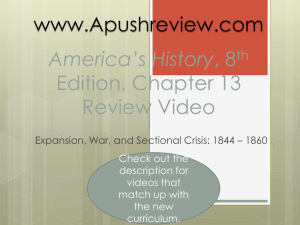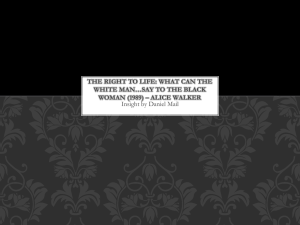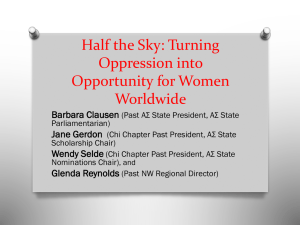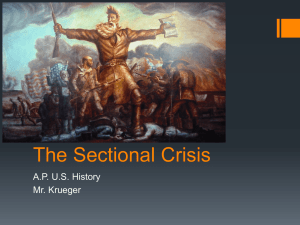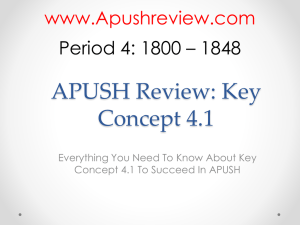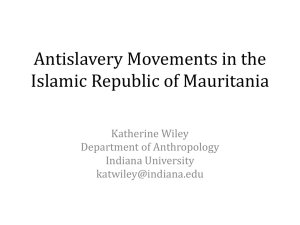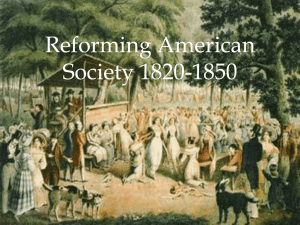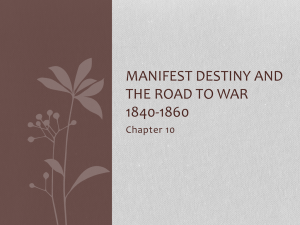Westward Expansion
advertisement
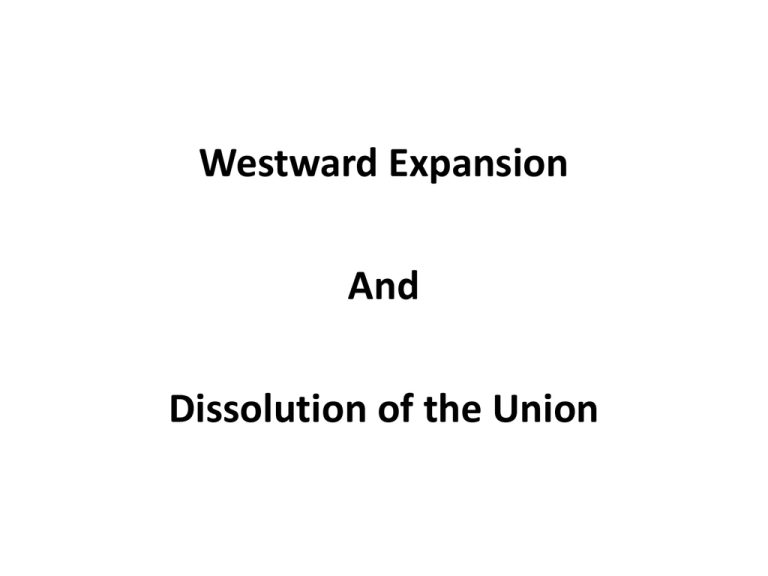
Westward Expansion And Dissolution of the Union “The expansion of the United States to the Pacific was a process involving many overlapping and diverse frontiers—of cultures, peoples, and even animals and disease….Ominously, the acquisition of new lands also reopened the debate over slavery and the Union.” 2 Manifest (and Not So Manifest) Destinies The Roots of the Doctrine – Many Americans believed that their country had a divine mission to populate the continent – Americans believed that their social and economic system should spread globally – The Mexican Borderlands – Centers of California society: San Diego, Santa Barbara, Monterey, and San Francisco – New Mexico society dominated by ranchero families 3 Mexico • Spain had focused much attention on the Sugar Islands and South and Central America— essentially they had ignored Mexico and all the lands that made up Tejas or Texas—except when needing to tax the region. • Under the Mission System thousands of Indians and tejas peoples were forced to become catholic and become laborers for the Spanish. • Trouble brewing—Americans looked a better ally than the Spanish. • Over the years the Comanche's and Apaches had gained control of the trade routes between Mexico and North America—to off set this the Spanish established the Ranchero System—again this was a failed system—too much like the Southern Slave System. • The Mexican Government in 1824 enacted a new system of allotting land grants to the Americans. This was to offset and contend with the large Indian issue still prevalent in the region. (Americans agreed to learn Spanish and convert to Catholicism) • By 1830, the Americans had established a trade with Santa Fe and North America—opting to forego the dangers of trying to trade with Mexico City some 1700 miles through very dangerous territory. • The Tejas people and the Americans engaged in heavy trade and soon forgot the Mexicans— • Mexico still benefitted from the trade, but soon there were overwhelming numbers of Americans • There were three (3) big issues that would put Texas on the road to revolution: • 1) Too many Americans flouted laws requiring the Spanish language and conversion to Catholicism; • 2) Introduced Slaves into the economy; Mexico abolished slavery in 1829. • 3) Openly supported American annexation. • Another major issue was the ineptness and corruptibility of Mexican government. The Texas Revolution – 1834 Santa Anna staged a coup, emasculated the constitution, set up a dictatorship; Texas revolted—Santa Anna determined to crush the rebellion. The Alamo – 187 Americans including Frontiersman Davy Crockett and Jim Bowie (knife fame) died defending the Alamo—not a good place to defend, but it became the rallying cry for Sam Houston and other Americans to join forces and defeat Santa Anna. 9 The Alamo—Davy Crockett dies a hero. • Texas becomes a republic, but it would be a few years before it would be a state. • Northerners were leery of allowing statehood due to the slave state and free state balance. • 1840s John Tyler and James K. Polk—this changes the Texas dynamic. Both were proslavery advocates and pro statehood. • Polk secured the Oregon boundary 54 40 or fight with Great Britain—clear now to focus on Texas • He was able to push through annexation in 1845— the issue, the southern boundary between Texas and Mexico. • He sent John Slidell with 20 million dollars to deal with Mexico (purchase California and New Mexico also)—they refused. • If Mexico gave California to England for debt relief—it would be disastrous. America claimed the border was the Rio Grande—Mexico said it was the Nueces River. • Polk dispatched Zachary Taylor to the Rio Grande to protect American interest—the war was no on. (first war where journalist were embedded with troops) • It was a two year war—America was victorious; now controlled all of Northern Mexico. • What to do with slavery placed an enormous strain on the two-party system—Third Party emerged—The Free Soil Party—dedicated to blocking slavery from the territories. The Price of Victory – Conquest of Mexico brought slavery to the center of national politics (westward expansion was on) The Rise of the Slavery Issue – Northern discontent—Free Soil Party—morph into the Republican party – Wilmot Proviso—banned slavery from all conquered lands from Mexico – Southerners denounced the Proviso as a veiled attack against slavery. – Polk tried to get support for extending the 36 30 Mo compromise line all the way to California—Northerners opposed—an attempt to bring slavery into the conquered territories. 14 The Gold Rush (California an issue now) began on January 24, 1848, when gold was found by James W. Marshall at Sutter's Mill, in Coloma, California.[1] News of the discovery brought some 300,000 people to California from the rest of the United States and abroad. The human and environmental costs of the Gold Rush were substantial. Native Americans, dependent on traditional hunting and gathering, became the victims of starvation and disease, as gravel, silt and toxic chemicals from prospecting operations killed fish and destroyed habitats 15 • Instant City: San Francisco – San Francisco’s chaotic growth – Land prices soared, speculation was rampant, and commercial forces became paramount The Migration from China – In 1860 San Francisco was 50 percent foreign-born – Most Chinese who arrived came from Southern China around Canton – After the initial boom was ending, explicitly anti-foreign and racist attacks, laws and confiscatory taxes sought to drive out foreigners from the mines, but especially the Chinese and Latin American immigrants 16 Gold Rush ‘49er The Caning of Charles Sumner – May 22, 1856: Rep. Preston Brooks caned Sen. Sumner in reaction to the latter’s slander of a relative of Brooks’ – Significance of the caning was in its imagery of the violence South was willing to undertake in defense of slavery – He defamed and mocked Brooks’ Uncle Andrew Butler who had suffered from a stroke— – (So did Brooks cane him for the slave issue or for mocking his uncle’s infirmity) 18 Kansas-Nebraska Act • This was a bill introduced by Stephen Douglas that introduced the concept of Popular Sovereignty. • Allow the population by ballot to decide on the slavery issue. • It created a political explosion and people who originally had no opinion on slavery now jumped onto the slavery bandwagon The Lecompton Constitution – Proslavery forces in Kansas crafted constitution to protect slavery – Congress returned the constitution to Kansas for another vote, in which it failed “The attempt to force slavery on the people of Kansas drove many conservative northerners into the Republican party.” 20 Lecompton Constitution • The Lecompton Constitution was the second of four proposed constitutions (it was preceded by the Topeka Constitution and followed by the Leavenworth and Wyandotte). The document was written in response to the anti-slavery position of the 1855 Topeka Constitution of James H. Lane and other free-state advocates. The territorial legislature, consisting mostly of slave-owners, met at the designated capital of Lecompton in September 1857 to produce a rival document. Free-state supporters, who comprised a large majority of actual settlers, boycotted the vote. Buchanan's appointee as territorial governor of Kansas, Robert J. Walker, although a strong defender of slavery, opposed the blatant injustice of the Constitution and resigned rather than implement it • This new constitution enshrined slavery and protected the rights of slaveholders. Ii also provided for a referendum of popular sovereignty. • Both the Topeka and Lecompton constitutions were placed before the people of the Kansas Territory for a vote, and both votes were boycotted by supporters of the opposing faction. The Lecompton vote boiled down to a "Constitution with Slavery" v. "Constitution with no Slavery." But the "Constitution with no Slavery" clause would have not made Kansas a free state; it merely banned future importation of slaves into Kansas. • Boycotted by free-soilers, both it and the Topeka Constitution were sent to Washington for approval by Congress. • President Buchanan endorsed the Lecompton Constitution. While the president received the support of the Southern Democrats, many Northern Democrats, led by Stephen A. Douglas, sided with the Republicans in opposition to the constitution. • A new referendum was proposed, even though this would delay Kansas's admission to the Union. Furthermore, a new constitution, the anti-slavery Leavenworth Constitution, was already being drafted. On 4 January 1858, Kansas voters, overwhelmingly rejected the Lecompton proposal by a vote of 10,226 to 138. (Kansas admitted as Free State in 1861). The Election of 1856 – American party nominated Fillmore; Republicans nominated Frémont – Ideology of the Republican party rested on belief in free labor – Rising belief in the Slave Power, disproportionate influence of the planter class – Heritage of republicanism important – Buchanan won 24 National Issues Linked to Slavery Missouri Compromises of 1820 and 1830 The constitution forbid government interference with slavery where it already existed—abolitionists hoped to prevent its expansion into the territories Missouri sought to enter the union in 1818 as a slave state—this upset the political balance between free soil and slave states— admitted Maine as a free soil state and Mo. As a slave state to maintain the senatorial balance—Remember Alabama had entered as a slave state (1819)–the Senate was perfectly balanced. • The issue was the territory acquired through the Louisiana Purchase (1803) and what would be acquired through the Mexican War (1846-47) a few years later. • The rub was the Compromise also provided that slavery would be excluded from the newly settled Louisiana territory except below the latitude 36° 30'. • The Compromise of 1850 • Because of the California issue—free state—slave state balance, Henry Clay fashioned a compromise. • California a free state; New Mexico into two (Utah) territories, both would eventually decide by Popular Sovereignty whether to accept slavery or not. • Settled the border dispute between Texas and New Mexico—again slavery being the deciding issue. Government would assume Texas’ debt, banned the slave trade in the nations capitol and enforce a stronger Fugitive slave act. (Caveat* banned the trade, not slavery itself) • Fire-storm of controversy. Pro Slavery advocates were outraged that slavery was to be considered—the constitution sanctioned slavery—leave it alone. • John C. Calhoun—”The South asks for simple justice … terminate agitation and save the Union.” • Slavery was legal it should be protected and perpetuated rather than weakened and destroyed—it was the northerners breaking constitutional law—not southerners. Harriet Beecher Stowe • A literary event that shook the American public—It was an indictment of the slave system and in particular Southerners themselves— • this would decrease the South’s chances of having a foreign power (ally) to intervene on their behalf when the war started. Dred Scott Case • 1857--Scott sued for freedom on the grounds that Emerson, though since dead, and bequeathed to his wife Sandford, had taken him to a free soil state where slavery was illegal therefore by definition of law he must be free. • The U.S. Supreme Court ruled otherwise—since Scott was not a true American citizen he had no right to sue in local or federal court. Chief Justice Roger B. Taney said “A slave had no rights which a white men need acknowledge” Backlash of Court Decision • Also ruled Congress had no right to ban slavery in the territories; • Concluded that the Mo. Compromise was unconstitutional; therefore repealed. • Slavery was legal and Guaranteed by constitution; congress no authority to arbitrarily illegalize it. Lincoln – Douglas Debates • The 1858 debates addressed the issue of western slavery; • Douglas believed in Popular Sovereignty; • Lincoln, on the other hand, argued that slavery was “a moral, a social, and a political wrong.” A Sectional Election – Division of the Democratic party in 1860 produced two candidates, Douglas and Breckenridge – Republicans nominated Lincoln, who won with the smallest percentage of the popular vote in the nation’s history “For the first time, the nation had elected a president who headed a completely sectional party and who was committed to stopping the expansion of slavery.” 33 John Brown’s Raid • South now convinced the North would resort to violent means such as armed insurrection to destroy their way of life. • Regardless of morality, many southerners were not going to sit idly by allow insurrectionists to kill their families. • Southern Militia’s now prepare and become the basis of the Confederate Army Into the Abyss • December 20th 1860, South Carolina signed its Ordinance of Secession; absolved itself of allegiance to the United States. • In the words of John C. Calhoun and Thomas Jefferson (Virginia and Kentucky Resolutions 1790)— asserting States Rights. • (April 12th 1861, 0430am—”The Night They Drove Ol Dixie Down—” The Band, 1970). Conclusion • Slavery was the institution by which the South defined itself; But it was the existence of slavery, with its negative impact on politics, economics, and social relations, which fatally crippled the South in its bid for independence. • Jefferson Davis lamented after the war: “The South died of a theory,” and an arrogance of superiority.
